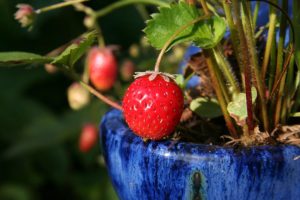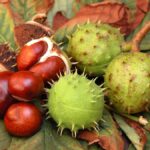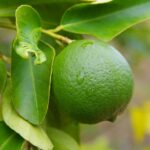The peak season for flavorful, naturally sweet strawberries is late spring. Local strawberries at the peak of their natural season are most likely to be the tastiest strawberries you will eat all year.
Strawberries are perennial herbs that grow in temperate zones all over the world. There are native strawberries in Europe, Central Asia, North America, and South America.
The strawberry flesh you eat is actually a false fruit, a swollen edible stalk. The tiny yellow dots or seeds that cover the berry’s surface are the plant’s real fruits.
Five delicious ways to serve fresh harvested strawberries
1. Strawberry Spinach Salad with Balsamic Dressing
Ingredients:
- 2 cups fresh strawberries, hulled and sliced
- 4 cups baby spinach
- 1/4 cup crumbled goat cheese or feta
- 1/4 cup sliced almonds, toasted
- 1/4 red onion, thinly sliced
- 2 tbsp balsamic vinaigrette
- Optional: 1 tbsp poppy seeds
Instructions:
- In a large bowl, combine the baby spinach, sliced strawberries, goat cheese, almonds, and red onion.
- Drizzle with balsamic vinaigrette and toss gently to coat.
- Sprinkle with poppy seeds for an added crunch if desired.
- Serve as a refreshing side salad or light main dish.
2. Strawberry Shortcake
Ingredients:
- 2 cups fresh strawberries, hulled and sliced
- 2 tbsp sugar (optional)
- 2 cups all-purpose flour
- 2 tbsp sugar (for shortcake)
- 1 tbsp baking powder
- 1/2 tsp salt
- 1/2 cup unsalted butter, cold and cut into cubes
- 2/3 cup milk
- Whipped cream for topping
Instructions:
- Preheat the oven to 425°F (220°C). Line a baking sheet with parchment paper.
- Toss the sliced strawberries with 2 tbsp of sugar and set aside to macerate.
- In a mixing bowl, whisk together flour, 2 tbsp sugar, baking powder, and salt.
- Cut in the cold butter until the mixture resembles coarse crumbs. Stir in the milk until just combined.
- Drop spoonfuls of the dough onto the baking sheet to form shortcakes.
- Bake for 12-15 minutes or until golden brown. Let cool slightly.
- Slice the shortcakes in half, layer with strawberries and whipped cream, and top with the other half of the shortcake. Add more whipped cream and strawberries on top before serving.
3. Strawberry Bruschetta
Ingredients:
- 1 baguette, sliced and toasted
- 1 cup fresh strawberries, diced
- 1/4 cup fresh basil, chopped
- 2 tbsp balsamic glaze
- 1/4 cup ricotta cheese or cream cheese
- Salt and black pepper to taste
Instructions:
- In a bowl, mix the diced strawberries and basil with a pinch of salt and black pepper.
- Spread ricotta cheese or cream cheese on each toasted baguette slice.
- Spoon the strawberry-basil mixture onto each slice.
- Drizzle with balsamic glaze and serve as an elegant appetizer or snack.
4. Strawberry Smoothie Bowl
Ingredients:
- 1 1/2 cups fresh strawberries, hulled
- 1 banana, frozen and sliced
- 1/2 cup Greek yogurt
- 1/2 cup almond milk or any preferred milk
- Toppings: sliced strawberries, granola, chia seeds, coconut flakes, and fresh mint
Instructions:
- Blend the strawberries, banana, Greek yogurt, and almond milk until smooth and thick.
- Pour the mixture into a bowl and top with sliced strawberries, granola, chia seeds, coconut flakes, and fresh mint.
- Serve immediately for a nutritious and visually appealing breakfast or snack.
5. Chocolate-Dipped Strawberries
Ingredients:
- 2 cups fresh whole strawberries, washed and dried thoroughly
- 1 cup dark or milk chocolate chips
- 1/2 cup white chocolate chips (optional for drizzling)
- 1 tsp coconut oil (optional, for a smoother melt)
Instructions:
- Line a baking sheet with parchment paper.
- Melt the dark or milk chocolate chips in a heatproof bowl over a double boiler or in the microwave in 30-second increments, stirring in between. Add coconut oil if using.
- Dip each strawberry into the melted chocolate, letting excess drip off, and place it on the parchment paper.
- Melt the white chocolate and use a fork or piping bag to drizzle over the dipped strawberries for decoration.
- Chill in the refrigerator for 30 minutes or until the chocolate hardens.
- Serve as a delightful dessert or sweet snack.
These recipes highlight the sweet, juicy flavor of fresh strawberries in a variety of ways!
More strawberry serving suggestions
Use fresh as a dessert fruit or serve with cream and a little sugar or in fruit salads, mousses, and ice cream. Use strawberries in pies, cakes, and soufflés. Process strawberries into jams, jellies, preserves, sweets, and fruit juices. Steep them in wine, champagne, brandy, or liqueur.
How to make strawberry butter
Strawberry butter is just what waffles need. That is strawberry butter and strawberries.
Strawberry butter is tasty on homemade bread, rolls, muffins, biscuits, pancakes, and waffles.
Spring and early summer are the time for strawberries. Strawberry shortcakes, strawberry tarts, and strawberry ice cream are all in season in spring and early summer.
Choose strawberries that are full, red, shiny, and ripe. If you get hold of strawberries with green patches, set them aside on the kitchen counter overnight in a single layer and let them ripen. No need to force your enjoyment of strawberries, only settle for strawberries that are sweet and ripe.
The best-tasting strawberries are the ones harvested the day after they reach ripeness. This means you need to keep your fingers on the strawberries this time of year so that you can enjoy them when they are most tasty.
Here are the directions for making strawberry butter:
- ½ cup sliced strawberries
- 1 tablespoon honey
- ½ cup butter at room temperature
In a medium-sized bowl, mash the strawberries and honey together. Use an electric mixer or a potato masher and gradually beat in half of the butter. Give it a chance; it will blend together even if the mix seems reluctant at first. When half the butter has been added, whip in the remaining butter–if you are using an electric mixer increase the speed from medium to high. Soon the mix will be light and fluffy. If this strawberry butter doesn’t go straight on your waffles, you can pack the mix into a mold or crock and cover it tightly with plastic wrap and refrigerate until ready for use. Makes about 3/4 cup.
How to make strawberry cheese
This little stuffed strawberry dish is a dessert appetizer snack. It’s a great way to do something different with strawberries other than eat them out of hand–which is pretty hard to beat.
You don’t have to stuff strawberries with this strawberry cheese, you can just spread this mix on muffins or toast or crackers.
Makes about 1½ cup
- 6 ounces of cream cheese
- 1½ teaspoons toasted poppy seeds
- ⅓ Cup finely chopped strawberries
- Several whole strawberries for stuffing
In a small bowl, mix together cheese, poppy seeds, and chopped strawberries. Stuff several hollowed-out strawberries–this amount will stuff about two dozen good size strawberries.
You can also spoon this strawberry cheese into a small, decorative serving dish and garnish with whole strawberry and thyme and serve with crudités or little squares of toast.
Types of strawberries
There are three major classifications of strawberries: June-bearing strawberries (also called summer strawberries), everbearing strawberries, and alpine and wild strawberries.
There are hundreds of cultivars of June-bearing and everbearing strawberries. What they all have in common is that they are modern hybrids—mostly human-made creations.
June-bearing
June-bearing strawberry varieties produce one crop per year in late spring or early summer, usually from mid-May through early July in the Northern Hemisphere but as early as April in California and Florida. Most June-bearing strawberries are plump and red, but their flavors vary. The fruit production of June-bearing summer strawberries is triggered by the lengthening daylight hours of late spring and summer.
Ever-bearing
Everbearing strawberry varieties begin setting fruit before June-bearing strawberries and produce strawberries continuously through the late spring, all summer, and into the fall. Like June-bearing strawberries, everbearing strawberries are plump and red, but their flavors vary by variety. The fruit production of everbearing strawberries is mostly unaffected by day length, however, the peak of their harvest is early summer with a second crop usually in the early fall.
Modern cultivars
June-bearing and everbearing strawberry varieties are sometimes lumped together and called “modern strawberries” and sometimes “garden strawberries” because they are hybrids. Both categories can be traced back to the cross-breeding of two important natural strawberry varieties: the Chilean strawberry (also called the pine or beach strawberry) and the North American strawberry (also called the scarlet or Virginia strawberry).
From the pineapple strawberry, many modern cultivars have since been developed. There are hundreds of named strawberry cultivars. One of the most famous is the Royal Sovereign which was developed in 1892. The Royal Sovereign is considered by some to be the greatest strawberry of all time. It is a large, bluntly conical strawberry with a deep red color and intensely sweet flavor.
The most far-reaching development of the modern strawberry began in 1945 when the University of California started an ongoing strawberry hybridization program. The results—which continue–have been the introduction of larger, hardier, and more prolific strawberries that are easily shipped long distances. Not all are the sweetest tasting.
The strawberries you find nearly year-round in grocery stores today are in all likelihood modern hybrids that may have not been locally grown.
Strawberry varieties
There are more than 600 varieties or cultivars (cultivated varieties) of strawberries. They come in many sizes, colors, and flavors.
- June-bearing or summer strawberry varieties include ‘Allstar’, ‘Earliglow’, ‘Guardian’, ‘Jewel’, ‘Lateglow’, ‘Robinson’, ‘Surecrop’, ‘Sparkle’, and ‘Winona’.
- Everbearing varieties include ‘Fort Laramie’, ‘Ogalla’, ‘Ozark Beauty’, ‘Quinault’, ‘Tristar’, and ‘Tribune’.
- Cultivated varieties of alpine and wild strawberries include ‘Baron Solemacher’, ‘Pineapple Alpine Rugen’, and ‘Yellow Alpine’.

How to choose strawberries
Select plump, bright, shiny red berries, with fresh-looking caps. Dull-colored strawberries are usually overripe. Avoid strawberries that are soft or moldy.
All strawberries large and small can be sweet and juicy; however, smaller berries may be more flavorful because they contain less water.
The smallest bump will bruise a strawberry and cause it to rot. One rotten strawberry can contaminate other berries in a container.
How to store strawberries
Cover and refrigerate strawberries without washing for 1 or 2 days. Lightly wrap the top of the container in plastic. Avoid leaving them at room temperature or in the sun.
Do not crowd or press strawberries and remove any damaged berries as soon as possible.
Washed or overripe strawberries will keep longer if you add a bit of sugar. Add lemon or apple juice to berries to reduce the loss of vitamin C after they have been cut and exposed to air.
Whole, sliced, quartered, or crushed strawberries can be frozen.
How to prepare strawberries
Wash strawberries when you are ready to use them. Rinse in cold water but avoid soaking strawberries. They will absorb water and lose flavor. Do not hull strawberries until you are ready to use them or they may lose juice.
Hull strawberries with a small paring knife cut out the core in a cone shape.
Strawberry flavor partners
Strawberries have a flavor affinity for almonds, balsamic vinegar, blackberries, blueberries, champagne, custards, heavy cream, kirsch, lemon, melon, sour cream, sugar, walnuts, and whipped cream.
Strawberry nutrition
Strawberries are an excellent source of vitamin C and a good source of potassium and folic acid, vitamin B, and magnesium.
About strawberries
Why are strawberries called strawberries? The word ‘strawberry’ dates back nearly 2,000 years to the Anglo-Saxons. Is it because the strawberry runners look like straw? Or because the berry’s external seeds look like little golden bits of chaff? No one knows.
The North American strawberry was discovered by Europeans settling in Massachusetts in 1621. The North American strawberry was found growing along much of the eastern coast of what was to become the United States of America. It was also called the Virginia strawberry. This strawberry which was noted for its excellent flavor and scarlet coloring was introduced to Europe in 1624.
The Chilean strawberry was discovered in the Andes mountain range of Chile by the French military explorer François Amédée Frézier in 1714. Frézier returned the Chilean strawberry to France. The Chilean strawberry was noted for its large size.
Already growing in Europe before the introduction of the North American strawberry and the Chilean strawberry were two native or wild European strawberries: the alpine strawberry and the musk strawberry. Both the alpine and musk strawberries produced very small but very flavorful berries over a short season. These berries could be green, white, yellow, or red when fully ripe.
By the seventeenth century alpine and musk strawberries made their way from the wild into European gardens including the royal gardens of the Louvre in Paris. There the musk strawberry came to be known also as hautbois (from the French hautbois) or best berry and is still valued today for its flavor and fragrance.
Wild strawberries are also called by the French name fraises des Bois—strawberries from the woods. Many gourmets say today that the flavor and scent of fraises des Bois surpass cultivated strawberries.
In European gardens, the alpine and musk strawberries met the North American and Chilean strawberries, and, more importantly, the two western hemisphere strawberries met each other. In about 1750 in France, the Chilean strawberry from the west coast of South America and the North American strawberry from the east coast of North America were crossed. The result was the modern strawberry—popularly known as the pineapple strawberry.
The pineapple strawberry is a large, deep red strawberry with a rich, sweet pineapple flavor.
The botanical name for the European wild strawberry is Fragaria vesca; the Chilean strawberry, F. chiloensis; the North American strawberry, F. virginiana; the musk strawberry, F. moschata; and the garden or pineapple strawberry, F.x ananassa.
The name strawberry may be a corruption of the English word “strew.” The strawberry plant strews or scatters new plants when it sends out runners and the fruit is strewn among its leaves. As well, the yellow achenes or seeds of the strawberry plant are straw-colored.
The Latin name for the strawberry Fragaria is derived from the Latin fraga or fragrance referring to the fruit’s fragrance.
Also of interest:
Related articles:
Planning the Home Fruit Garden
Garden Planning Books at Amazon:
- Vegetable Garden Almanac & Planner
- Kitchen Garden Grower’s Guide Vegetable Encyclopedia
- Vegetable Garden Grower’s Guide
- Tomato Grower’s Answer Book
More kitchen tips:
Bring your harvest to the table. Kitchen prep tips and easy recipes for the vegetables you grow. Click below for vegetable prep and recipes you can use now.
- Almonds
- Apples
- Apricot
- Aprium
- Artichoke
- Arugula
- Asparagus
- Avocado
- Bamboo Shoots
- Banana
- Basil
- Beans, Dried
- Beans. Long
- Beans, Shell
- Beans, Snap
- Beets
- Bitter Melon
- Blackberry
- Bok Choy
- Broccoli
- Broccoli Raab
- Brussels Sprouts
- Cabbage
- Cardoon
- Carrots
- Cauliflower
- Celeriac
- Celery
- Chard
- Chayote Squash
- Cherimoya
- Cherries
- Chestnut
- Chickpea
- Chinese Cabbage
- Chives
- Cilantro
- Citron
- Clementine
- Collards
- Coriander
- Corn, Sweet
- Corn, Baby
- Corn Salad, Mache
- Cranberry
- Cress
- Cucumber
- Daikon
- Dandelion
- Dill
- Eggplant
- Endive, Belgian
- Endive and Escarole
- Fava Beans
- Fig
- Florence Fennel
- Garlic
- Ginger
- Grapefruit
- Grapes
- Guava
- Horseradish
- Jerusalem Artichoke
- Jicama
- Jujube
- Kale
- Kiwifruit
- Kohlrabi
- Kumquat
- Leeks
- Lemongrass
- Lemons
- Lettuce
- Lime
- Mache (Corn Salad)
- Mandarin Orange
- Mango
- Maple Syrup
- Marjoram
- Melons
- Michihili
- Mint
- Mizuna
- Mushrooms
- Mushrooms, Cremini
- Mustard Greens
- Napa Cabbage
- Nectarine
- Okra
- Olives
- Olive oil
- Onions
- Oranges
- Oregano
- Parsley
- Parsley Root
- Parsnips
- Passion Fruit
- Pawpaw
- Peaches
- Pears
- Peas, Garden Snap
- Peas, Snow
- Pei Tsai
- Peppers, Chili
- Peppers, Sweet
- Persimmon
- Pineapple
- Pineapple Guava
- Plantain
- Plums
- Pluots
- Pomegranate
- Potatoes
- Prickly Pear
- Pumpkin
- Quince
- Radicchio
- Radishes
- Raspberries
- Rosemary
- Rhubarb
- Rutabaga
- Sage
- Salsify
- Sauerkraut
- Savory
- Shallots
- Sorrel
- Spinach
- Squash, Summer
- Squash, Winter
- Strawberries
- Sunchokes
- Sunflower
- Sweet Potato
- Swiss Chard
- Tangerine
- Taro
- Tarragon
- Thyme
- Tomatillo
- Tomato
- Turnip
- Turnip Greens
- Yams















